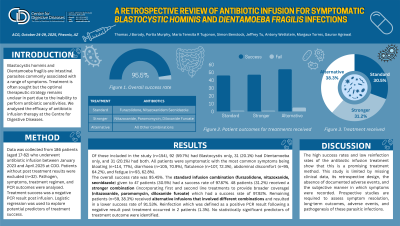Monday Poster Session
Category: Infections and Microbiome
P3422 - A Retrospective Review of Antibiotic Infusion for Symptomatic Blastocystis hominis and Dientamoeba fragilis Infections
Monday, October 27, 2025
10:30 AM - 4:00 PM PDT
Location: Exhibit Hall

Has Audio

Thomas J. Borody, MBBS, MD, PhD, BSc, FACG
Centre for Digestive Diseases
Five Dock, New South Wales, Australia
Presenting Author(s)
Thomas J. Borody, MBBS, MD, PhD, BSc, FACG, Portia Murphy, BSc, Maria Teresita R.. Tugonon, RN, Simon Benstock, MBBS, BSc, Jeffrey Tu, MBBS, Antony Wettstein, MBBS, Margaux Torres, BSc, Gaurav Agrawal, MBBS, MRCP
Centre for Digestive Diseases, Five Dock, New South Wales, Australia
Introduction: Blastocystis hominis and Dientamoeba fragilis are intestinal parasites commonly associated with a range of symptoms. Treatment is often sought but the optimal therapeutic strategy remains unclear in part due to the inability to perform antibiotic sensitivities. We analysed the efficacy of antibiotic infusion therapy at the Centre for Digestive Diseases.
Methods: Data was collected from 154 patients (aged 17-82) who underwent antibiotic infusion between January 2023 and April 2025 at CDD. Patients without post treatment results were excluded (n=32). Pathogen, symptoms, treatment regimen, and PCR outcomes were analysed. Treatment success was a negative PCR result post infusion. Logistic regression was used to explore potential predictors of treatment success.
Results: Of those included in the study 92 (59.7%) had Blastocystis only, 31 (20.1%) had Dientamoeba only, and 31 (20.1%) had both. All patients were symptomatic with the most common symptoms being bloating (n=114, 77%), diarrhoea (n=105, 70.9%), flatulence (n=107, 72.3%), abdominal discomfort (n=95, 64.2%), and fatigue (n=93, 62.8%).
The overall success rate was 95.45%. The standard infusion combination (furazolidone, nitazoxanide, secnidazole) given to 47 patients (30.5%) had a success rate of 97.87%. 48 patients (31.2%) received a stronger combination (incorporating first and second line treatments to provide broader coverage) (nitazoxanide, paromomycin, diloxanide furoate) which had a success rate of 97.92%. Remaining patients (n=59, 38.3%) received alternative infusions that involved different combinations and resulted in a lower success rate of 91.53%. Reinfection which was defined as a positive PCR result following a negative result post treatment occurred in 2 patients (1.3%). No statistically significant predictors of treatment outcome were identified.
Discussion: The high success rates and low reinfection rates of the antibiotic infusion treatment show that this is a promising treatment method. This study is limited by missing clinical data, its retrospective design, the absence of documented adverse events, and the subjective manner in which symptoms were recorded. Prospective studies are required to assess symptom resolution, long-term outcomes, adverse events, and pathogenesis of these parasitic infections.
Disclosures:
Thomas J. Borody, MBBS, MD, PhD, BSc, FACG, Portia Murphy, BSc, Maria Teresita R.. Tugonon, RN, Simon Benstock, MBBS, BSc, Jeffrey Tu, MBBS, Antony Wettstein, MBBS, Margaux Torres, BSc, Gaurav Agrawal, MBBS, MRCP. P3422 - A Retrospective Review of Antibiotic Infusion for Symptomatic </i>Blastocystis hominis</i> and <i>Dientamoeba fragilis</i> Infections, ACG 2025 Annual Scientific Meeting Abstracts. Phoenix, AZ: American College of Gastroenterology.
Centre for Digestive Diseases, Five Dock, New South Wales, Australia
Introduction: Blastocystis hominis and Dientamoeba fragilis are intestinal parasites commonly associated with a range of symptoms. Treatment is often sought but the optimal therapeutic strategy remains unclear in part due to the inability to perform antibiotic sensitivities. We analysed the efficacy of antibiotic infusion therapy at the Centre for Digestive Diseases.
Methods: Data was collected from 154 patients (aged 17-82) who underwent antibiotic infusion between January 2023 and April 2025 at CDD. Patients without post treatment results were excluded (n=32). Pathogen, symptoms, treatment regimen, and PCR outcomes were analysed. Treatment success was a negative PCR result post infusion. Logistic regression was used to explore potential predictors of treatment success.
Results: Of those included in the study 92 (59.7%) had Blastocystis only, 31 (20.1%) had Dientamoeba only, and 31 (20.1%) had both. All patients were symptomatic with the most common symptoms being bloating (n=114, 77%), diarrhoea (n=105, 70.9%), flatulence (n=107, 72.3%), abdominal discomfort (n=95, 64.2%), and fatigue (n=93, 62.8%).
The overall success rate was 95.45%. The standard infusion combination (furazolidone, nitazoxanide, secnidazole) given to 47 patients (30.5%) had a success rate of 97.87%. 48 patients (31.2%) received a stronger combination (incorporating first and second line treatments to provide broader coverage) (nitazoxanide, paromomycin, diloxanide furoate) which had a success rate of 97.92%. Remaining patients (n=59, 38.3%) received alternative infusions that involved different combinations and resulted in a lower success rate of 91.53%. Reinfection which was defined as a positive PCR result following a negative result post treatment occurred in 2 patients (1.3%). No statistically significant predictors of treatment outcome were identified.
Discussion: The high success rates and low reinfection rates of the antibiotic infusion treatment show that this is a promising treatment method. This study is limited by missing clinical data, its retrospective design, the absence of documented adverse events, and the subjective manner in which symptoms were recorded. Prospective studies are required to assess symptom resolution, long-term outcomes, adverse events, and pathogenesis of these parasitic infections.
Disclosures:
Thomas Borody: Centre for Digestive Disease – Advisory Committee/Board Member, Owner/Ownership Interest.
Portia Murphy: Centre for Digestive Disease – Employee.
Maria Teresita Tugonon indicated no relevant financial relationships.
Simon Benstock: Centre for Digestive Disease – Independent Contractor.
Jeffrey Tu: Centre for Digestive Disease – Independent Contractor.
Antony Wettstein: Centre for Digestive Disease – Independent Contractor.
Margaux Torres: Centre for Digestive Disease – Employee.
Gaurav Agrawal: Centre for Digestive Disease – Independent Contractor.
Thomas J. Borody, MBBS, MD, PhD, BSc, FACG, Portia Murphy, BSc, Maria Teresita R.. Tugonon, RN, Simon Benstock, MBBS, BSc, Jeffrey Tu, MBBS, Antony Wettstein, MBBS, Margaux Torres, BSc, Gaurav Agrawal, MBBS, MRCP. P3422 - A Retrospective Review of Antibiotic Infusion for Symptomatic </i>Blastocystis hominis</i> and <i>Dientamoeba fragilis</i> Infections, ACG 2025 Annual Scientific Meeting Abstracts. Phoenix, AZ: American College of Gastroenterology.
